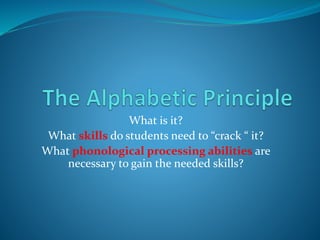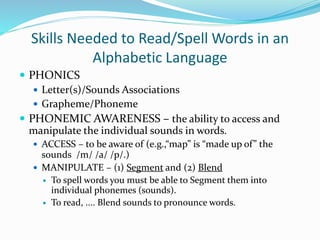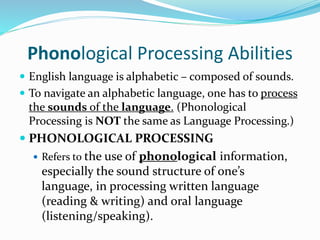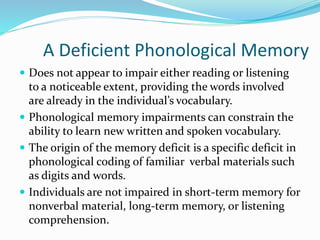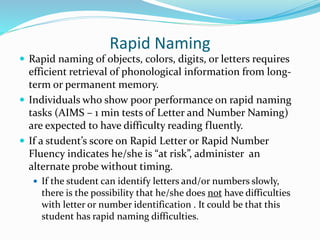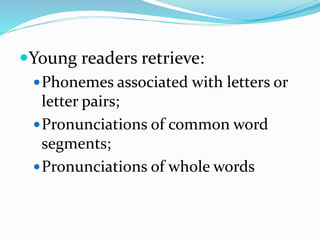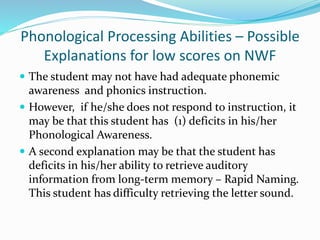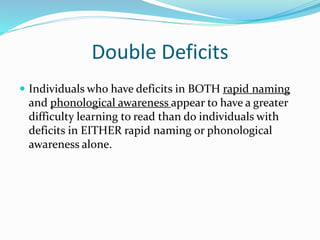The Alphabetic Principle
- 1. What is it? What skills do students need to ÔÇ£crack ÔÇ£ it? What phonological processing abilities are necessary to gain the needed skills?
- 2. English Language is Alphabetic ´éù Letters ÔÇ£makeÔÇØ sounds. ´éù Sounds are blended to decode words (if the words are decodable, and not irregular ). ´éù Words are segmented into individual sounds when encoding. ´éù The term phonological derives from the Greek word phone, which means ÔÇ£voiceÔÇØ or ÔÇ£sound.ÔÇØ
- 3. Skills Needed to Read/Spell Words in an Alphabetic Language ´éù PHONICS ´éù Letter(s)/Sounds Associations ´éù Grapheme/Phoneme ´éù PHONEMIC AWARENESS ÔÇô the ability to access and manipulate the individual sounds in words. ´éù ACCESS ÔÇô to be aware of (e.g.,ÔÇ£mapÔÇØ is ÔÇ£made up ofÔÇØ the sounds /m/ /a/ /p/.) ´éù MANIPULATE ÔÇô (1) Segment and (2) Blend ´éù To spell words you must be able to Segment them into individual phonemes (sounds). ´éù To read, .... Blend sounds to pronounce words.
- 4. Phonological Processing Abilities ´éù English language is alphabetic ÔÇô composed of sounds. ´éù To navigate an alphabetic language, one has to process the sounds of the language. (Phonological Processing is NOT the same as Language Processing.) ´éù PHONOLOGICAL PROCESSING ´éù Refers to the use of phonological information, especially the sound structure of oneÔÇÖs language, in processing written language (reading & writing) and oral language (listening/speaking).
- 5. Reading Disabilities ´éù The critical problem for the majority of cases of reading disability is at the level of decoding individual words. ´éù A deficit in some aspect of phonological processing ability is viewed as a cause of the most common form of reading disability. ´éù Deficits in phonological awareness, phonological memory and rapid naming are common in children with reading disabilities. ´éù These deficits appear to be the root of many of the decoding difficulties faced by individuals with reading difficulties.
- 6. 3 Kinds of Phonological Processing Abilities ´éù Phonological Awareness ÔÇô an individualÔÇÖs awareness of and access to the sound structure of his or her oral language. ´éù Phonological Memory ÔÇô the coding of information phonologically for temporary storage in working or short-term memory. ´éù When you attempt to remember a phone number, you store the number temporarily in working memory. ´éù You probably do so not by storing a visual representation of the sequence of digits (although you may be able to do this if you try, but rather by storing a phonological representation of the sounds of the digit names.
- 7. Phonological Memory ´éù Phonological Loop provides a brief, verbatim storage of auditory information. It consists of two parts. ´éù Phonological Store ÔÇô tape recording loop that retains the most recent 2 seconds worth of auditory information. ´éù Articulatory Control Process ÔÇô provides input to the phonological loop initially and also can refresh information already in the loop so it can be stored for longer than 2 seconds.
- 8. A Deficient Phonological Memory ´éù Does not appear to impair either reading or listening to a noticeable extent, providing the words involved are already in the individualÔÇÖs vocabulary. ´éù Phonological memory impairments can constrain the ability to learn new written and spoken vocabulary. ´éù The origin of the memory deficit is a specific deficit in phonological coding of familiar verbal materials such as digits and words. ´éù Individuals are not impaired in short-term memory for nonverbal material, long-term memory, or listening comprehension.
- 9. Rapid Naming ´éù Rapid naming of objects, colors, digits, or letters requires efficient retrieval of phonological information from long- term or permanent memory. ´éù Individuals who show poor performance on rapid naming tasks (AIMS ÔÇô 1 min tests of Letter and Number Naming) are expected to have difficulty reading fluently. ´éù If a studentÔÇÖs score on Rapid Letter or Rapid Number Fluency indicates he/she is ÔÇ£at riskÔÇØ, administer an alternate probe without timing. ´éù If the student can identify letters and/or numbers slowly, there is the possibility that he/she does not have difficulties with letter or number identification . It could be that this student has rapid naming difficulties.
- 10. ´éùYoung readers retrieve: ´éùPhonemes associated with letters or letter pairs; ´éùPronunciations of common word segments; ´éùPronunciations of whole words
- 11. AIMS Reading Measures ´éù Phoneme Segmentation Fluency ÔÇô if a student scores poorly on this measure, chances are that he/she is not accessing individual phonemes within words ÔÇô (e.g., weak phonemic awareness). If the total sounds per minute score is low, look at the test itself to examine the information qualitatively. (It is possible that the student is segmenting words into onsets and rimes. That may be an indication that he/she is 1.ÔÇ£unawareÔÇØ of medial phonemes, OR it could be that the student is 2. already a fairly good reader and is just segmenting quickly. If the student is segmenting words into onsets/rimes (rather than individual phonemes) double check to see which of the above two are applicable.
- 12. Good News re P.A. ´éù Of the three Phonological Processing Abilities ÔÇô Phonological Awareness is amenable to instruction (in other words, it can be improved with instruction). ´éù It is the only one of the 3 Phonological Processing Abilities that has been shown to be affected by instruction. However, good instruction can help students compensate for weakness in the other 2 processing abilities - Phonological Memory or Rapid Naming.
- 13. Nonsense Word Fluency ´éù NWF measures both Phonics and the ability to Blend. If a student scores poorly on this measure, explicit phonics instruction is a good place to start ÔÇô including (1)letter/sound association and (2)direct instruction in blending. ´éù If a studentÔÇÖs score is ÔÇ£emergingÔÇØ, but you are concerned by his/her reading performance, then take a look at the test itself. It may be that the student is naming individual sounds quickly, but he/she may not be blending sounds together to pronounce nonsense words. ´éù If test looks like this k o c , rather than k o c, re-administer using a different NWF probe - for second testing, change protocol ---
- 14. Qualitative Analysis of NWF ´éù If student ÔÇ£saysÔÇØ k o c, rather than k o c, explain to the student that he/she can pronounce the individual sounds, but the best way to read a word is to blend the sounds together. You can model for the child (since this is just for analysis ÔÇô not to score). Then ask him/her if he/she can read the nonsense word quickly. ´éù For k o c student ÔÇô direct blending instruction. ´éù For a student who ÔÇ£saysÔÇØ sounds slowly or incorrectly ÔÇô he/she may need is more instruction in letter/sound associations, along with instruction in blending.
- 15. Phonological Processing Abilities ÔÇô Possible Explanations for low scores on NWF ´éù The student may not have had adequate phonemic awareness and phonics instruction. ´éù However, if he/she does not respond to instruction, it may be that this student has (1) deficits in his/her Phonological Awareness. ´éù A second explanation may be that the student has deficits in his/her ability to retrieve auditory information from long-term memory ÔÇô Rapid Naming. This student has difficulty retrieving the letter sound.
- 16. Double Deficits ´éù Individuals who have deficits in BOTH rapid naming and phonological awareness appear to have a greater difficulty learning to read than do individuals with deficits in EITHER rapid naming or phonological awareness alone.
- 17. Oral Reading Fluency ´éù Tests of Early Literacy (PSF and NWF) are administered in K (beginning in spring) and 1st grade. ´éù The NWF is also administered during the first trimester of 2nd grade. However, -- ´éù If a student in 2nd or 3rd grade scores very poorly on the ORF, administer the NWF to get an idea of Phonics skills and his/her ability to Blend. ´éù If you are concerned about deficits in one or more of the studentÔÇÖs phonological processing abilities, let me know. I can administer the CTOPP (Comprehensive Test of Phonological Processing.
